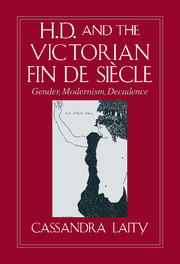Book contents
- Frontmatter
- Contents
- Acknowledgments
- Introduction: Dramatis Personae: The Aesthete Androgyne and the Femme Fatale
- 1 The Rhetoric of Anti-Romanticism: Gendered Genealogies of Male Modernism
- 2 H.D.'s Early Decadent Masks and Images: HER; Sea Garden
- The Aesthete Androgyne
- The Femme Fatale
- Postscript
- Notes
- Index
- CAMBRIDGE STUDIES IN AMERICAN LITERATURE AND CULTURE
2 - H.D.'s Early Decadent Masks and Images: HER; Sea Garden
Published online by Cambridge University Press: 06 January 2010
- Frontmatter
- Contents
- Acknowledgments
- Introduction: Dramatis Personae: The Aesthete Androgyne and the Femme Fatale
- 1 The Rhetoric of Anti-Romanticism: Gendered Genealogies of Male Modernism
- 2 H.D.'s Early Decadent Masks and Images: HER; Sea Garden
- The Aesthete Androgyne
- The Femme Fatale
- Postscript
- Notes
- Index
- CAMBRIDGE STUDIES IN AMERICAN LITERATURE AND CULTURE
Summary
H.D.'s Romantic Myth of Origins
In the same year that Eliot published his objections to the Romantic dissociation of sensibility (“The Metaphysical Poets”), H.D. completed her first fictional biography, Paint It Today (1921), in which her narrator presumed that the “stream” of literary history had diverted to the Victorian Romantics that formed the modernists' early reading:
I drift with the stream, since I believe the stream now to be drifting toward some ultimate land, … made up of the early visions of all the early poets we read when we were sixteen, whom we outgrew when we were twenty and whom we find again in our peaceful thirties.
(Paint It 69)Far from dissociating herself from the Wildean Aesthete, H.D.'s aspiring poet heroine in her fictional autobiography, Asphodel (composed 1921–22), regards the Aesthetes, headed by Wilde, as a parental tradition of sexually transgressive artists. Hermione begs her women lover to live with her in London by sentimentally invoking the Aesthete community and their code of “Greeks and flowers”:
“We are children of the Rossettis, of Burne Jones, of Swinburne. We were in the thoughts of Wilde when he spoke late at night … to a young man called Gilbert. They talked of Greeks and flowers. … We belong here.
(Asphodel 53, 54)And, as early as 1916, H.D. had evoked Romantic visionary landscape in her proposed agenda for modern poetry as the central image of a forged reconciliation between the Romantic past and the war-torn present.
- Type
- Chapter
- Information
- H. D. and the Victorian Fin de SiècleGender, Modernism, Decadence, pp. 29 - 60Publisher: Cambridge University PressPrint publication year: 1996



